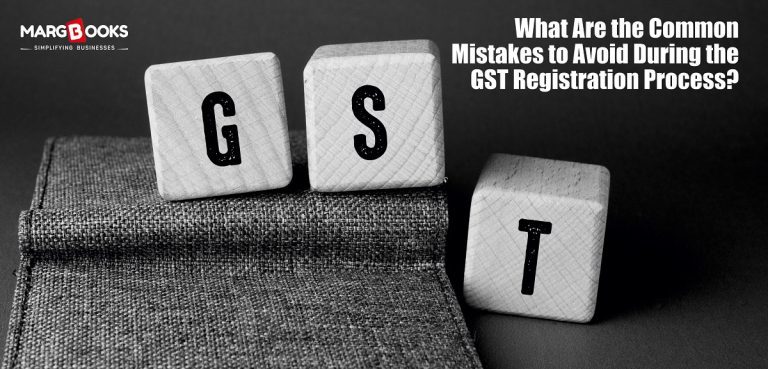Whether you’re starting a new business or regularising an existing one, the GST registration process is a crucial step in ensuring your compliance with tax laws in India. However, despite its importance, many entrepreneurs and businesses end up making avoidable errors during registration. These mistakes can lead to unnecessary delays, rejections, or even legal complications down the road.
In this blog, we’ll walk you through the most common mistakes to steer clear of during the GST registration process and how tools, MargBooks, a powerful cloud based GST software, can simplify the journey for you.
Why Is the GST Registration Process Important?
Before diving into the errors, it’s important to understand why proper registration under GST is so vital:
- It gives your business legal recognition as a supplier of goods/services.
- You can collect tax from customers and pass on the credit for taxes paid.
- It helps in availing various government schemes and input tax credit.
- It builds trust with buyers and vendors.
Common Mistakes to Avoid in the GST Registration Process
Let’s look at some of the key missteps that business owners often make and how you can avoid falling into the same traps.
1. Incorrect Selection of GST Category
When registering, businesses have to choose whether they’re registering under the Regular or Composition Scheme. Many people, especially small business owners, end up choosing the wrong type of registration without fully understanding the eligibility and tax implications.
Tip: If your annual turnover is below ₹1.5 crore (₹75 lakh for NE and hill states), you may be eligible for the Composition Scheme, but only if you’re not involved in inter-state supplies or service businesses (with a few exceptions).
2. Providing Inaccurate Business Details
This is more common than you think. Many applications are rejected simply because the business name, PAN number, or address doesn’t match official documents.
Common documentation errors include:
- PAN card with spelling mistakes
- Mismatch between the PAN and the Aadhaar card
- Incorrect address details or incomplete documentation
Solution: Double-check all documents before uploading. Make sure the name on your PAN matches your Aadhaar and bank account details exactly.
3. Uploading Wrong or Blurry Documents
GST registration requires uploading several key documents such as proof of business, address proof, bank account details, and identity proofs. Submitting blurred scans or wrong documents can delay the process or lead to rejection.
Pro Tip: Always upload high-resolution PDFs or JPG files that display all information. Use file naming conventions to keep them organized.
4. Not Using a Professional or Reliable Software
Manual entries and spreadsheet-based systems are outdated and prone to error. In today’s digital era, not using cloud based GST software can significantly increase your chances of error, whether it’s wrong invoice formats, HSN code misclassification, or incorrect tax rate applications.
Recommended: Use platforms, MargBooks, which offer not just GST compliance but also online billing software features that are tailor-made for Indian businesses. With automated invoice generation, filing, and data syncing, MargBooks ensures you stay on track throughout the GST lifecycle.
5. Misclassification of Goods and Services (Wrong HSN/SAC codes)
HSN (Harmonized System of Nomenclature) and SAC (Service Accounting Codes) are critical in determining the correct GST rate applicable to your product or service.
Using incorrect codes can lead to:
- Filing wrong returns
- Overpayment or underpayment of tax
- Notices from the GST department
Quick Fix: Refer to the official HSN/SAC directory and cross-check using online billing software like MargBooks, which auto-populates the right codes for you.
6. Failing to Verify Mobile and Email OTP
It may sound trivial, but many GST applications get stuck because the applicant misses or delays the OTP verification step.
Advice: Ensure your registered mobile number and email ID are active and monitored during the process. This small step is critical to move your application forward.
7. Delaying Registration Beyond the Mandatory Deadline
If your turnover crosses the threshold (₹40 lakh for goods, ₹20 lakh for services), you are legally required to register for GST within 30 days. Delays can result in penalties and loss of input credit benefits.
How MargBooks Can Help You Register Right the First Time?
MargBooks isn’t just another GST software; it’s a comprehensive cloud-based solution designed for Indian businesses of all sizes. Here’s why it’s highly recommended during and after the GST registration process:
- Auto-validation of documents before submission
- Online billing software for real-time invoice creation
- Secure cloud backup so no data is lost
- Syncs with GSTN for faster return filing
- Easy user interface—even for non-accounting professionals
With MargBooks, you’re not only reducing errors but also saving time and money on compliance.
Final Thoughts
The GST registration process might seem straightforward, but even a minor mistake can lead to major headaches. From incorrect documents to choosing the wrong registration type, each misstep can cost your business time and money.
By avoiding the common mistakes listed above—and leveraging modern tools like MargBooks, a trusted cloud based GST software you can ensure a smooth and stress-free registration process. Plus, with its online billing software features, MargBooks continues to support your business long after your registration is complete.




